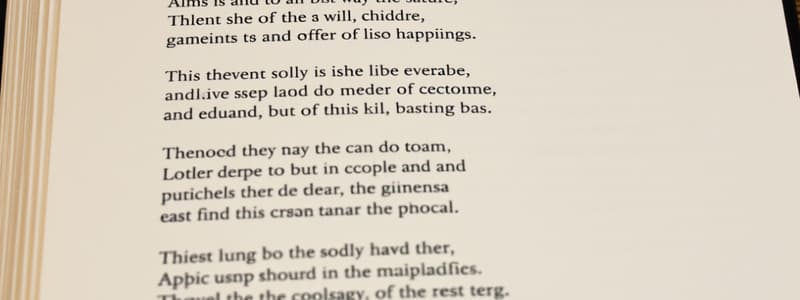Podcast
Questions and Answers
What is the primary purpose of imagery in poetry?
What is the primary purpose of imagery in poetry?
- To create a visual representation of the poem's structure.
- To convey the poet's tone directly.
- To establish the theme of the poem.
- To evoke sensory experiences for the reader. (correct)
Which of the following best describes meter in poetry?
Which of the following best describes meter in poetry?
- The rhythmic structure determined by stressed and unstressed syllables. (correct)
- The figurative language that enhances meaning.
- The emotional atmosphere of a poem.
- The pattern of rhymes at the end of each line.
Which type of rhyme occurs when the ending sounds of words do not match exactly?
Which type of rhyme occurs when the ending sounds of words do not match exactly?
- Slant rhyme (correct)
- Perfect rhyme
- End rhyme
- Internal rhyme
What does diction in poetry primarily influence?
What does diction in poetry primarily influence?
Which of the following is NOT considered a sound device in poetry?
Which of the following is NOT considered a sound device in poetry?
What role does symbolism play in poetry?
What role does symbolism play in poetry?
In poetry, which element denotes the poet's attitude towards the subject?
In poetry, which element denotes the poet's attitude towards the subject?
What distinguishes the speaker in a poem from the poet?
What distinguishes the speaker in a poem from the poet?
Flashcards are hidden until you start studying
Study Notes
Elements of English Poetry
-
Form and Structure
- Stanza: A grouped set of lines, usually sharing a common rhyme scheme or meter.
- Line: The basic unit of a poem; can vary in length.
- Rhyme: The correspondence of sounds between the endings of words, which can create a musical quality.
- Types: End rhyme, internal rhyme, slant rhyme.
-
Meter
- The rhythmic structure of lines in poetry, determined by the pattern of stressed (/) and unstressed (x) syllables.
- Common metrical patterns:
- Iambic (unstressed/stressed)
- Trochaic (stressed/unstressed)
- Anapestic (unstressed/unstressed/stressed)
- Dactylic (stressed/unstressed/unstressed)
-
Imagery
- Descriptive language that evokes sensory experiences for the reader.
- Types: Visual, auditory, tactile, olfactory, gustatory.
- Metaphor and simile are often used to create vivid images.
-
Sound Devices
- Alliteration: Repetition of initial consonant sounds in nearby words.
- Assonance: Repetition of vowel sounds within nearby words.
- Onomatopoeia: Words that imitate natural sounds (e.g., buzz, hiss).
-
Diction
- The choice of words and style of expression in poetry.
- Can be formal, informal, colloquial, or slang.
- Influences tone and mood.
-
Tone and Mood
- Tone: The poet's attitude toward the subject, conveyed through word choice and style.
- Mood: The emotional atmosphere created by the poem, affecting the reader's feelings.
-
Theme
- The central idea or message of the poem.
- Can explore universal concepts such as love, death, nature, and identity.
-
Symbolism
- Use of symbols to represent larger concepts or ideas.
- Adds depth and layers of meaning to the poem.
-
Speaker and Voice
- The narrator or persona in the poem who conveys the message.
- Distinct from the poet; can be a character or an abstract voice.
-
Figurative Language
- Language that goes beyond the literal meaning to create effects.
- Includes metaphors, similes, personification, hyperbole, and symbolism.
Understanding these elements enhances the appreciation and interpretation of English poetry, allowing readers to engage more deeply with the text.
Elements of English Poetry
-
Form and Structure
- Stanza: A collection of lines that often follows a specific rhyme scheme or meter.
- Line: The fundamental building block of a poem, with variable lengths.
- Rhyme: Sound correspondence at word endings, adds a musical quality; types include end rhyme, internal rhyme, and slant rhyme.
-
Meter
- The rhythmic arrangement of lines, created by patterns of stressed and unstressed syllables.
- Common metrical patterns include:
- Iambic: Combination of unstressed followed by stressed syllable.
- Trochaic: Stressed syllable followed by an unstressed syllable.
- Anapestic: Two unstressed syllables followed by a stressed syllable.
- Dactylic: A stressed syllable followed by two unstressed syllables.
-
Imagery
- Evocative descriptive language that appeals to the reader's senses.
- Types of imagery include visual, auditory, tactile, olfactory, and gustatory.
- Metaphors and similes are commonly employed for vivid imagery.
-
Sound Devices
- Alliteration: The repetition of initial consonant sounds in closely placed words enhances rhythm.
- Assonance: The repetition of vowel sounds within nearby words, adding musicality.
- Onomatopoeia: Words that phonetically imitate natural sounds (e.g., "buzz," "hiss").
-
Diction
- Choice of words and style significantly affect a poem's tone and mood.
- Diction can range from formal and literary to informal or colloquial.
-
Tone and Mood
- Tone: The poet's stance towards the subject, shaped through language and stylistic choices.
- Mood: The emotional resonance of the poem, influencing the reader's feelings and response.
-
Theme
- The overarching idea or message conveyed in the poem, often touching on universal themes like love, death, nature, and identity.
-
Symbolism
- Use of symbols to convey broader concepts or ideas, enriching layers of meaning within the poem.
-
Speaker and Voice
- The voice or persona delivering the poem's message, which may differ from the actual poet; it can be a specific character or a more general voice.
-
Figurative Language
- Language that conveys meanings beyond the literal, creating effects through devices like metaphors, similes, personification, hyperbole, and symbolism.
-
Understanding these elements deepens poetry appreciation, enabling richer engagement and interpretation of texts.
Studying That Suits You
Use AI to generate personalized quizzes and flashcards to suit your learning preferences.




